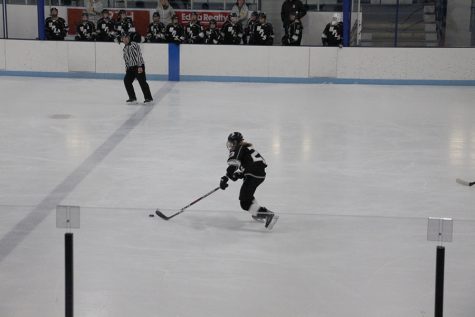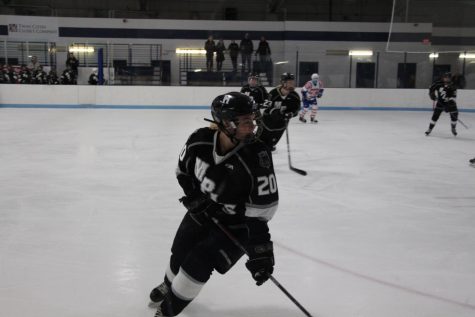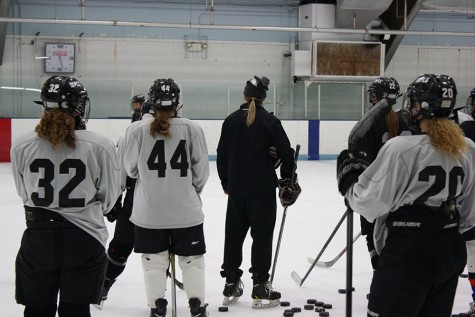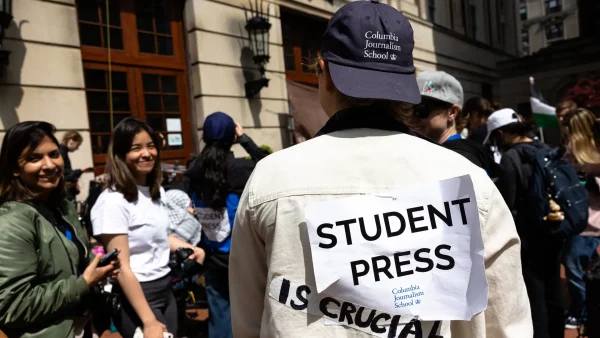“It’s a lot different”- the return of winter sports
Senior Eliana Storkamp, one of the captains of South’s nordic skiing team, during a race this season. “For practice we are required to wear a mask the entire time, but for races it’s different. When you first are at the start of the race they want you to be wearing a [face covering]… and once you start racing you can put it down and put it back up when you finish.” Photo credit: Kate Anderson
February 23, 2021
It’s been a challenging time for pretty much everything, including the sports world. Now, after being put on hiatus, high school winter sports have finally started up again. Teams have had to make adjustments including fewer games, mask policies, and no locker rooms, all in an effort to stop the spread of Covid-19.
According to the Minnesota State High School League (MSHSL), 153 student athletes tested positive for Covid-19 between January 15th and 29th, a two-week span. Encouragingly, only 0.43% of winter sports participants tested positive for Covid-19 during this span. However, 253 programs, or 18% of the MSHSL programs, were directly affected by positive tests. Several practices and competitions ended up being canceled because of these setbacks.
In order to keep the season going, covid safety guidelines have been set. “I play hockey, and it’s a lot different, we usually have locker rooms and stuff like that, but we [now] come all dressed except for our skates and our helmets, and we sit in the bleachers six feet apart and get ready,” said senior Lily Andersen.
Besides the absence of locker rooms and time to get dressed, hockey also has a mask policy. “Mask policy is any time you’re in the rink, it has to be on, [we] have to have a mask in… our helmet built in, and during games we’re required to wear masks the whole time,” said Meir Hetletvedt, a senior on the boy’s hockey team.
The mask policy varies from sport to sport. For example, MSHSL policy states that sports like hockey and basketball require you to wear a face covering at all times, while sports like swimming and wrestling have exceptions (for swimming you don’t have to wear a mask in the pool, and for wrestling you don’t have to wear one when you compete).
Another sport that has exceptions to the face covering policy is nordic skiing. “For practice we are required to wear a mask the entire time, but for races it’s different. When you first are at the start of the race they want you to be wearing a [face covering]… and once you start racing you can put it down and put it back up when you finish,” said senior Eliana Storkamp, one of the captains on South’s nordic team.
However, just because there is a face covering policy doesn’t mean everyone is following it. “’I’ve seen [that] a lot of the teams when we go out farther north, they aren’t as good about [wearing masks], some don’t wear it at all… We talk to the refs and are like, ‘we’re not comfortable playing if they don’t have them on,’ and it does a little bit, but sometimes the girls don’t want to do it,” said Andersen. She continued, “You gotta do it because you might not think that it’s [important] to you, but it’s not ok, it’s disrespectful to everybody that’s playing.”
The guidelines on face coverings that the MSHSL uses were set by the Minnesota Department of Health, and they are not recommended, but required. The face covering policy is enforced by Minnesota Executive Order 20-81, and there are potential penalties to rulebreakers. Potentially due to some participants not wearing face coverings, there have been outbreaks in several sports, most notably in wrestling, where 36 student athletes tested positive for Covid-19 between January 15-29th.
So what is the solution to reprimand athletes who aren’t wearing their masks? Andersen has an idea. “I think that they should give out penalties… in hockey we have [a] very rare penalty that you’ll get if you aren’t wearing a mouthguard, they’ll give you a 10 minute penalty. And [with the] mouthguard [penalty], it’s usually only if you’ve been asked multiple times to do it or just aren’t wearing it at all, but it’s because of safety. And I don’t see any reason why this shouldn’t be held in the same regard [with masks].”
Despite some mask mishaps and covid safety guidelines, athletes believe that the season has remained competitive. “I don’t think [competitiveness has been sacrificed] because races have still felt similar, I still am competing against people, so that’s good, but it really has limited the amount of races that we’ve gotten to have. We’re probably going to have half as many as we usually have because the season kept on getting postponed, by now we would already be done with the season. They did extend [the season], but yeah, that’s the one thing for competition, they just cut a lot of them out,” said Storkamp.
While the season feels competitive now, it also took a while to get used to. No team travel, locker rooms, and limited workouts are all new challenges athletes have faced this year. “I felt like the first game or two it was a little hindered, we were all getting used to it. I think practices have been a little slow to begin, but I think as we are kind of getting underway with the season, it’s getting more intense and more normal,” said Hetletvedt.
Team bonding moments were another thing sports have had to do without this season. “One thing that sucks is that we don’t get any training trips… I know a lot of people doing skiing really like [being on the team] because of Maple Log… [The whole team will] go for over a week to Maple Log and ski, and that’s a really great experience and it also helps unite the team a lot. I think we get to know people [from that], and I feel like it’s made it a lot harder in some ways to get to know people and have the same connections you would normally. Also not being able to go on the bus together [is tough], that was another unifying experience that everyone had,” said Storkamp.
Overall, South’s athletes agree with the covid guidelines, even if they can be frustrating or hard to follow. However, there are some guidelines that players don’t particularly enjoy. “Right now they don’t let us bring bags into the rink as well… we’re supposed to come in gear, so leaving, it makes it really annoying to try and carry all your gear out, so I wish they would just let us bring bags in… you got your water bottle, and your sticks, and your skates on your sticks, and you’re wearing hockey gloves at the same time, so it’s a pain to try and carry it all,” said Hetletvedt.
After being postponed for so long, winter sports coming back left student athletes feeling grateful, especially seniors since it’s their last year on the team. It was a season like no other, there was an abundance of cancelations, only to come back with a limited amount of things athletes could do while playing their sport. The season definitely taught student athletes something, whether it was flexibility or the importance of even getting to play. Overall, the lessons learned this season were beyond sports. “It’s really taught me how differently everyone sees everything, and how different each area is, and how important it is to advocate for yourself, your teammates, and your safety,” said Andersen.

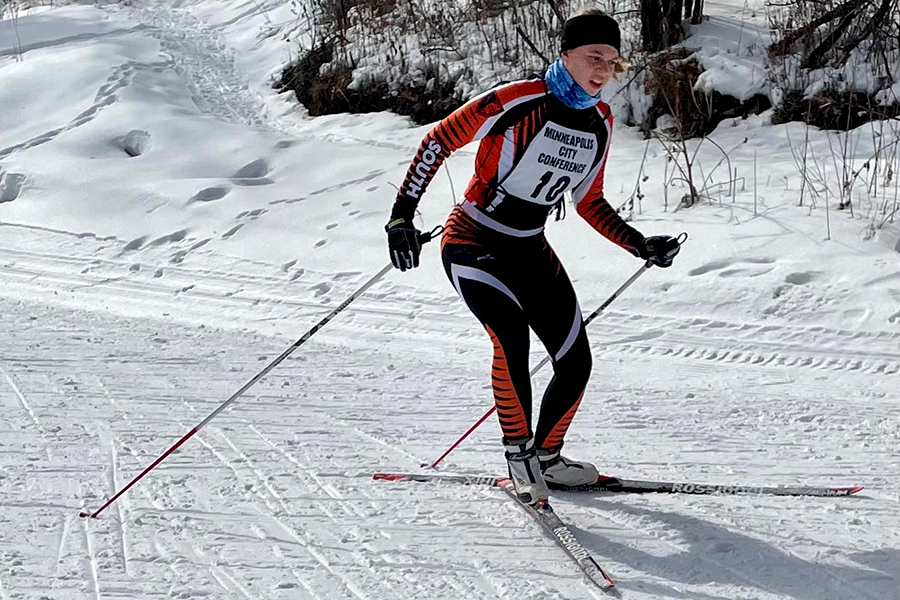

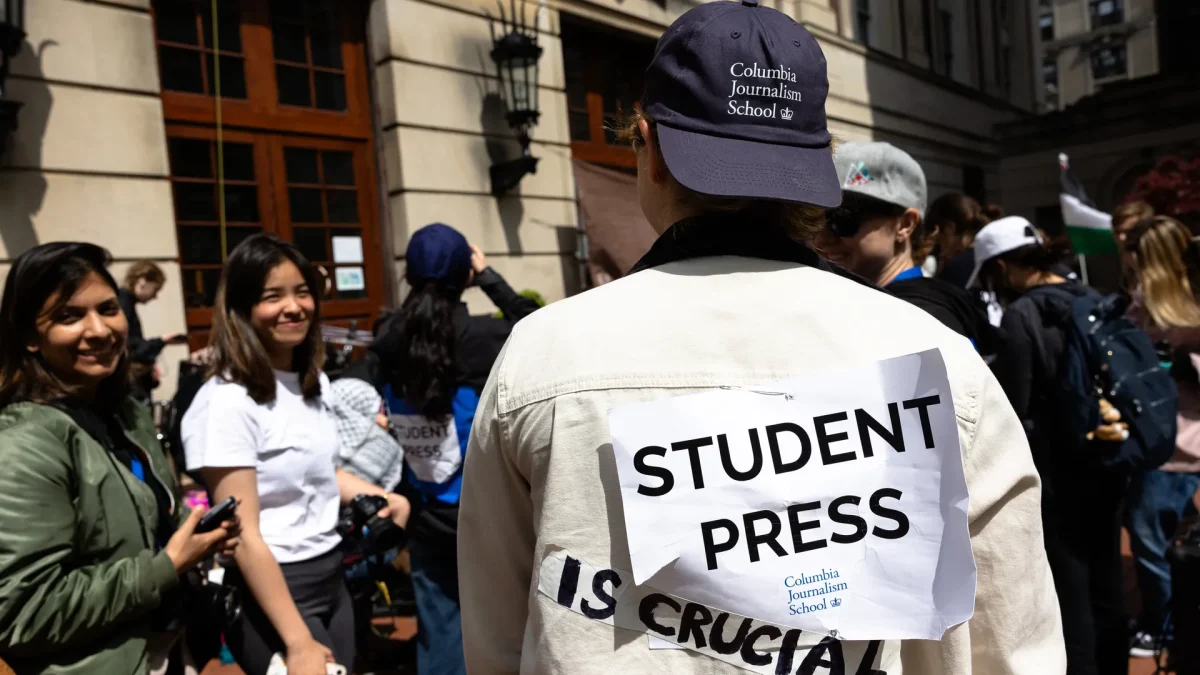


![South’s main rival is Southwest and occasionally Washburn, but when it comes to hockey, the Holy Angels lead the pack as their main enemy. According to hockey player Maddy Helmstetter, rivalries are an important motivator. “I think a lot of our girls build off of [the rivalries] and it makes them want to do better,” said Helmstetter.](https://www.shsoutherner.net/wp-content/uploads/2020/02/sports-rivalries-475x288.jpg)
